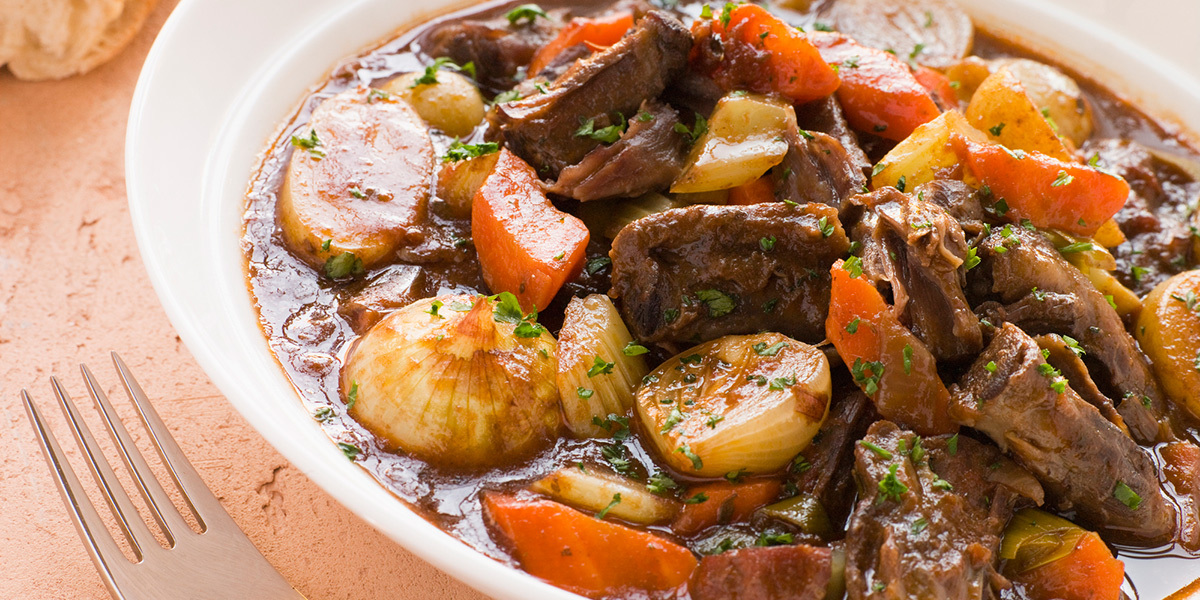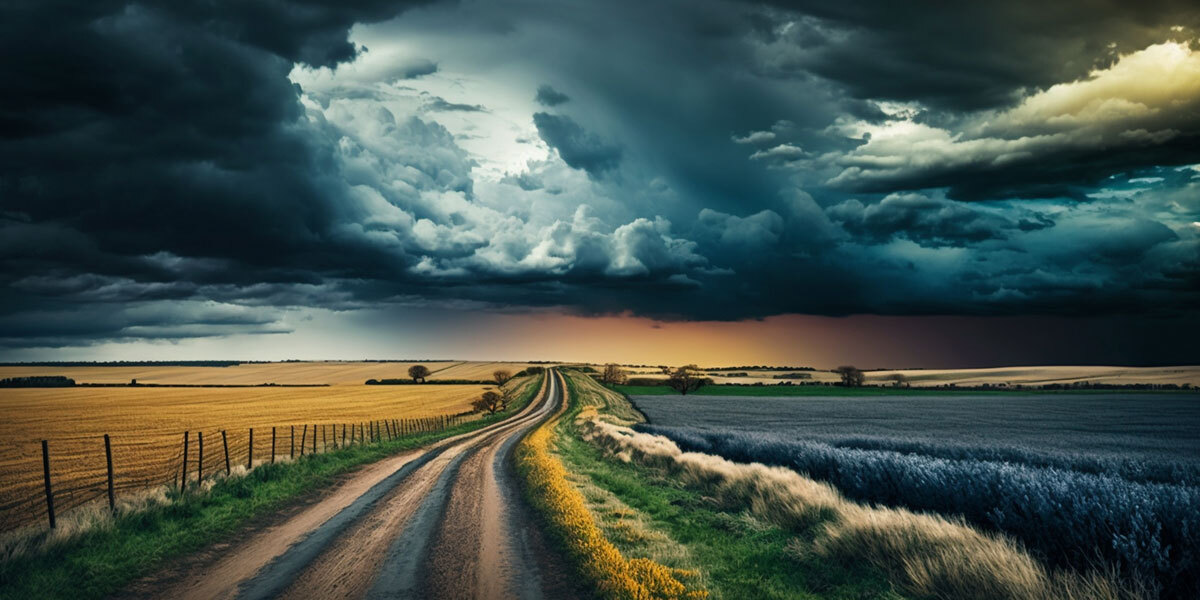

6 Wild Game Stew Recipes You’ll Love
When hunting season is in full swing, many of us will suddenly find cuts of deer, wild boar, rabbit, pheasant or geese in our freezers, thanks to friends, local butchers or our own hunting trips. But the meat of wild game is different from farm-raised meat in several ways and should be treated differently.
Wild game also calls for different cooking techniques since wild animals tend to be leaner and older than their farm-raised counterparts. It has to be properly aged and marinated to reduce its telltale gamey flavor.
Stew is a good way to prepare game because the long cooking times and broth result in tender, moist meat. Here are some ferociously tasty recipes for stews using several different species of wild game:

Wild Boar Stew with Mushroom and Red Wine
- 3 pounds wild boar mini roast
- 2 ounces Italian pancetta, finely sliced
- 12 ounces white mushrooms
- ½ pound dried porcini mushrooms
- 1 white onion
- 1 carrot
- 2 cloves garlic
- 3 tablespoons extra virgin olive oil
- 2 tablespoons unsalted butter
- 1 teaspoon cornstarch
- 1 bottle good quality red wine
- 4 leaves fresh sage
- 1 sprig fresh rosemary
- 1 tablespoon double-concentrated tomato paste
- 1 teaspoon paprika
- 1 teaspoon yellow mustard seeds
- 1 cinnamon stick
- 3 juniper berries
- 2 cloves
- 1 teaspoon ground pepper
- Salt to taste
Marinating the roast beforehand can remove some of the gamey taste and also tenderize the meat. Here’s a popular method: Submerge the boar roast in wine (not the wine called for in the ingredients list) mixed with the same herbs and seasoning that will be used in the recipe. Let it sit for a day or two, then discard the marinade.
Mince the pancetta, place into a heavy pot and cook over low heat. Add a tablespoon of olive oil, mustard seeds, cloves, cinnamon stick, paprika, sage leaves and juniper berries (or use a little extra rosemary and a few drops of lemon if you don’t have juniper berries).
As the pancetta renders, coarsely cut the carrot and onion and peel and crush one of the garlic cloves. Add to the pot. When the onion becomes translucent, add the tomato paste and stir for a couple of minutes. Set the mixture aside in a bowl.
Cut the meat into 1-inch pieces. Add a couple of tablespoons of olive oil to the pot and sear the meat, several pieces at a time, until golden on all sides, then add the vegetables and submerge in more red wine. Turn the heat to high for a few minutes to heat the wine (if it doesn’t start boiling, that’s fine), then reduce the heat to low and cook for 3 hours.
Submerge the dried porcini mushrooms in a cup of warm water. Clean the white mushrooms, quarter and sauté them in a pan with 2 tablespoons of melted butter and the second garlic clove, peeled and crushed. Stir fry the mushrooms over high heat for a few minutes, and then mince the porcini (don’t discard the water!). Finally, add the minced porcini to the pan and continue cooking until the porcini juices are mostly evaporated.
Once the wild boar is done cooking, remove the meat from the other ingredients and discard the cinnamon stick and rosemary sprig. Strain the remaining porcini water and add to the stew along with 1 teaspoon of cornstarch. Use a blender to smooth out the resulting sauce. Pour the sauce into a pot with the meat and mushrooms and cook over low heat until thickened. Add salt and pepper to taste and serve.

Wild Goose Stew
- 3½ to 4 pounds goose breasts
- 5 tablespoons oil
- 1 cup lardons (bacon ¼ inch thick by 1 inch long)
- ½ cup chopped onion
- 2 tablespoons flour
- 2 cups chicken stock
- 2 to 3 cups marinade
- 1 tablespoon cognac
- ½ cup heavy cream
- 3 cloves garlic, crushed
- 2 tablespoon fresh, finely chopped thyme
- 3 bay leaves
- 2 tablespoons fresh, chopped rosemary
- Salt and pepper to taste
Marinade
- 3 cups full-bodied red wine
- 1 cup sliced onion
- 1 cup coarsely sliced carrots
- 1 tablespoon red wine vinegar
- ¼ teaspoon ground black pepper
- 2 cloves
- 2 bay leaves
- 2 peeled and crushed cloves garlic
- Pinch of thyme
First, cut the goose breasts into 1-inch pieces. Mix marinade ingredients in a bowl and add the goose meat. Make sure that all of the goose meat is submerged in the marinade, cover the bowl and refrigerate for at least two days.
When the meat has been marinated, drain the meat in a colander and strain the liquid into a small saucepan. Keep the strained vegetables. Bring the marinade to a boil, skim it and set it aside for use in the stew later.
Preheat the oven to 400 degrees F and season the meat with salt and pepper. Sear the meat on all sides in 2 tablespoons of heated oil in a large pan or skillet (you may have to do this in several stages. Don't put too much meat in the skillet at once). Put the seared meat aside.
Heat 2 tablespoons of oil in a Dutch oven and sauté the lardons, adding the onions once the bacon is lightly browned. Cook the lardons and onions for about 5 minutes or until the onions are translucent. Pour off the grease, add the seared goose meat and place uncovered into the oven for about 10 minutes.
Next, coat the meat with flour and add the vegetables and herbs from the marinade, plus the chicken stock. Pour the strained and boiled marinade over the meat until everything is completely submerged. Cover the stew and put in the oven for an hour, then reduce to 325 degrees F for two more hours. The stew is ready when the meat can be easily pierced with a fork.
Remove the stew from the oven and add the garlic, thyme, rosemary, bay leaves, cognac and heavy cream. Your wild goose stew is officially cooked.

Food Plot Venison Stew
- ¾ cup black-eyed peas
- ¾ cup rye berries (barley, oat groats or wheat berries can also be used)
- 3 tablespoons unsalted butter
- 2 to 3 pounds venison stew meat
- 1 large onion, sliced thin
- 6 cups venison broth (beef broth works too)
- 1 teaspoon dried thyme
- ¼ teaspoon celery seed
- 1 pound turnips or rutabagas, peeled and diced into chunks
- 4 cups chopped dandelion greens (chicory leaves, kale or chard can also be used)
- Salt to taste
Garnish
- 4 to 5 red radishes, sliced thin
- Roasted pumpkin seed oil (or walnut oil or olive oil)
- Vetch or pea flowers (optional)
Place the black-eyed peas and the rye berries in bowls of boiling water and let them sit for an hour or longer, then simmer the rye berries in a small pot of boiling water for about an hour.
While the rye berries are simmering, melt the butter in a Dutch oven over medium-high heat. Pat the venison dry, salt it and brown the meat in the Dutch oven. You may have to do this in stages. Once all of the venison pieces are browned, set them aside in a bowl.
Add the onion and cook for about 5 minutes. Place the meat back into the pot and add the broth, thyme and celery seeds. Simmer for an hour.
Add the turnips (or rutabagas) and the black-eyed peas and simmer again for another hour.
By now the rye berries should be tender enough to remove from the water, so drain them and put them aside.
Add the rye berries and the dandelion greens about 5 minutes before you serve the stew. Finally, drizzle the pumpkin seed oil (or walnut oil or olive oil) just before serving and grind some pepper to taste.
NOTE: A food plot is an area of land planted with crops that are attractive to certain types of wild game, such as deer. The hunter then sets up a blind or tree stand and waits for the game to drop by for a snack.

Pheasant and Quail Stew
- 4 quail breasts (bone-in)
- 2 pheasant breasts (bone-in)
- 5 or 6 mushrooms, diced
- 2 celery stalks (sliced)
- 3 carrots (sliced)
- ½ white onion (sliced)
- 1 8-ounce can chicken stock
- 1 8-ounce can beef stock
- 1 8-ounce can mixed vegetables (peas, carrots, corn)
- 1 8-ounce can sweet peas (drained)
- 2 chicken bullion cubes
- Garlic powder
- Onion powder
- Seasoned salt
- Black pepper
- Poultry seasoning
- Vegetable oil
- Flour
- Water
Heat some vegetable oil in a large pot and add mushrooms, carrots, onion and celery stalks. Season to taste with garlic and onion powders, seasoned salt and poultry seasoning. Cook for about 10 minutes.
Once the vegetables are tender, add both 8-ounce cans of stock, bullion cubes and the quail and pheasant breasts. Cover with enough water to submerge the breasts by about an inch. Season the mixture again with the garlic and onion powders, seasoned salt and poultry seasoning. Bring the water to a boil and continue to cook on medium heat for about an hour (the water level should be about on the same level as the breasts).
Remove the breasts, debone them and return to the stew. Add the cans of mixed vegetables and sweet peas, seasoning the stew once more according to taste. Continue cooking for another 30 minutes or so and then add some pre-mixed flour and cold water (very gradually until the liquid thickens). Once the stew reaches the desired thickness and seasoning levels, it’s ready to serve!

French Rabbit Stew
- 4½ pounds rabbit
- 3 carrots (sliced)
- 2 onions (chopped)
- 10 button mushrooms
- 4 ½ cups red wine
- ½ cup olive oil
- 2 tablespoons butter
- 2 tablespoons flour
- ½ cup cognac or brandy
- 5 garlic cloves (minced)
- ½ cup bacon (chopped)
- 1 tablespoon tomato paste
- Pinch of thyme (to taste)
- Pinch of laurel (to taste)
- A small amount of water
Slice the rabbit into bite-sized pieces. Warm the olive oil and butter in a Dutch oven and cook the rabbit meat until lightly browned. Stir in the flour and add the cognac or brandy. Bring to a light boil, remembering to scrape the bottom constantly to release extra flavors and prevent burning.
Add the onions, minced garlic and bacon and stir while cooking for 5 minutes. Add the tomato paste, thyme and laurel. When everything is thoroughly combined, add the red wine until the meat is covered. If the meat is not covered, add water. Drop in the chopped carrots, reduce to a simmer, cover and cook for at least 2 hours.
Strain the meat and vegetables through a sieve, reserving the liquid. Take half of the cooked carrots and half of the cooked onions, along with a few bacon strips, and blend in a blender with the liquid until smooth.
Sauté the mushrooms separately in a skillet with butter. When the mushrooms are ready, mix everything together: the meat and vegetables, the liquid and the mushrooms. Refrigerate overnight and reheat to serve the next day.

Rocky Mountain Elk Stew
- 4 tablespoons butter, canola oil or sunflower oil
- 2 to 3 pounds elk stew meat (neck or front shoulder meat if possible, sliced across the grain)
- Salt
- ½ cup flour
- 1 large yellow onion, chopped
- 4 cloves garlic, minced
- 1 ounce dried porcini, crushed (or some other dried mushroom — if you can't find any, use ½ pound fresh mushrooms, chopped, and add with the onions)
- 5 Hatch, Anaheim poblano peppers, roasted, seeded and chopped
- 1 quart elk, venison or beef stock
- 1 pint Belgian beer (anything malty)
- 2 large carrots, peeled and cut into chunks
- 1 tablespoon fresh sage, minced
Optional Ingredients
- 1 parsnip, peeled and cut into chunks
- 1 cup corn kernels
- 1 cup cooked barley or wheat berries
- 1 15-ounce can Great Northern beans
- 1 cup chopped cooked greens, like spinach, nettles or chard
Heat 2 tablespoons of the butter or oil in a large soup pot with a lid over medium-high heat. Salt the stew meat well, then dust in the flour. Brown the meat in batches, making sure they do not touch each other. Remove the meat to a bowl as it browns and reserve.
When all the meat is nicely browned, add the remaining oil and the chopped onion. Stir well, and brown this well, too.
While this is happening, put 2 of the roasted chiles into a blender with the stock and puree.
Add the garlic and stir to combine. Return the meat to the pot, along with any juices that have collected in the bowl. Pour the contents of the blender into the pot. Crush the dried mushrooms in your hands and add to the pot. Fill the blender bowl again with water and pour that into the pot. Finally, add the beer. Bring all this to a simmer, add salt to taste, partially cover the pot, and let this cook gently.
If you are using dried beans, wheat berries or barley and greens, now is the time to cook them. If you are using canned beans, wait.
After about 2 hours, add the carrots and the sage, as well as the parsnip, if using. When they are tender, about 40 minutes or so later, add the remaining green chiles, and any of the other optional ingredients you happen to be using. Taste for salt and black pepper and serve.
NOTE: Take your time with the browning step for both the meat and onions. This is the foundation of the stew's flavor.






 PRO LOGIN
PRO LOGIN